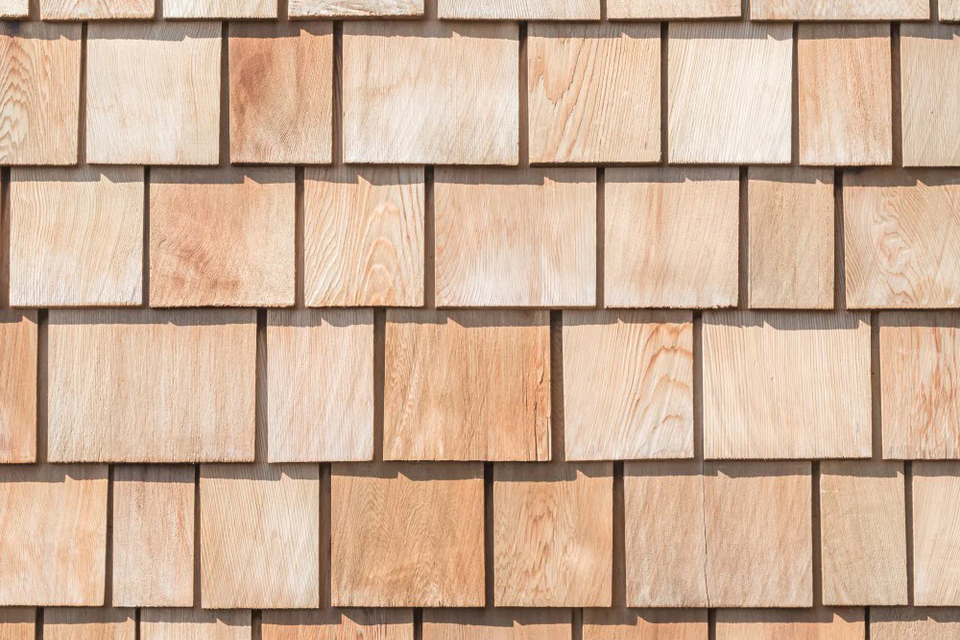White Cedar Shingles have been a popular siding material in New England since Colonial times. They were America’s answer to traditional European exterior finishes like brick, stone and stucco and white cedar sidewall shingles have defined the Cape Cod architectural style since the early 1600’s. White cedar is a wonderfully durable species that requires amazingly low maintenance. We have a building in our Hyannis yard that we shingled with white cedar 44 years ago. We have done nothing to those shingles except a gentle “soft wash” earlier this year to remove a bit of mildew and they look good enough to last another 40 years.
Life in colonial times didn’t allow a lot of time for maintenance and in those times, paint was not readily available nor inexpensive, so naturally weathering indigenous white cedar was an efficient choice for low maintenance long lasting protection. The overlap is created with 5” showing to the weather meant triple overlap on a 16” shingle. Although cedar shingles are thin, typically starting with a 3/8” butt tapering to less than half of that at the head of the shingle, the buildup of several layers provides very effective weather protection and even adds some insulation to the building envelope. With weather severe enough, that it is named after our region (Nor’ Easters), what works in New England typically works most anywhere. Unlike most of Europe, cedar was available in abundance, so white cedar became a popular siding choice for early settlers and has continued as a logical choice right up until today. It’s amusing that for 10,000 years, mankind has been trying to replace wood with alternatives, yet wood remains a staple of residential construction, combining easy workability, local sourcing, renewable supply and long lasting, low maintenance.
Early shingles were literally split from pre-cut blocks of straight grained wood called bolts. A mallet and froe (a type of axe) were used to split or rive the shingles one at a time. Hand splits were thicker than the 3/8’ shingles we commonly get today. By the mid 1800’s machinery became available to efficiently saw shingles and white cedar shingles began to be mass produced. Eastern Canada possesses the best supply of white cedar trees in North America and the combination of mass production capabilities and more efficient transportation really opened the American market to Canadian producers. Today there are only a handful of small white cedar shingle mills in the northern part of the US, and the great majority of white cedar shingles produced come from Quebec and the Maritime Provinces of Canada.
"Today there are only a handful of small white cedar shingle mills in the northern part of the US, and the great majority of white cedar shingles produced come from Quebec and the Maritime Provinces of Canada."
Trucking has really eased the work of getting shingles to market. Although Cape Cod and the Islands are the epicenter of white cedar consumption and our architecture is defined by the look of weathered white cedar sidewall shingles, we do get calls from around the country and have shipped white cedar shingles as far away as Florida and California to folks who want to take our Cape style look with them.
Today’s white cedar shingle typically come re-squared and re-butted which greatly speeds up installation by not requiring the traditional hand shaving to get out of square shingles to fit together. Re-butting really gives a uniform smooth look to the butt of the shingle and saws these days are not only carbide tipped, but also the blades are changed frequently to give a good finish to the face and edges of the shingle. Shingles manufacturing is still a very manual process, even with modern equipment because the human eye is still the best grading device we have available. Scanners are not able to pick up the subtle differences between dark graining and knots and a skilled sawyer is still the most critical element of the cedar shingle process. A good sawyer is a model of constant motion and split-second decision making. As he reaches to his left to grab each shingle off a 4’ diameter spinning saw blade that slices the shingle off the bolt, he scans the shingle and then cuts out defects on a spring-loaded saw table. After, he sorts the resulting shingles by grade into different slots that carry the shingles to different conveyor lines. He moves so fast it is mesmerizing and he does this for hours on end. It is dangerous work and there are plenty of 7 or 8 fingered sawyers to prove it. A sawyer’s job requires dexterity, stamina, and extremely quick processing. It takes two years to train a sawyer and many more to make a good one. Although subsequent workers down the line are looking at the shingles for grading, while sorting or bundling the shingles, the sawyer is the one who sets the tone and determines the basic grade and quality of what he cuts. Click here to view a short video of the shingle manufacturing process!
We carefully choose the white cedar mills whose stock we sell. Grading rules have a range, and some mills grade to the bottom of that range and some grade to the top, so it does matter whom we choose. Cedar shingle production suffered during COVID, and supplies were very short. We are pleased to be back with a good supply of high-quality shingles available and proud to supply shingle style house designs throughout our market. Here’s to a renewable product milled into an aesthetically pleasing siding, that is extremely low maintenance and very long lasting. White Cedar Shingles have earned their popularity for all the right reasons, from the days of the Pilgrims right up until the present.
